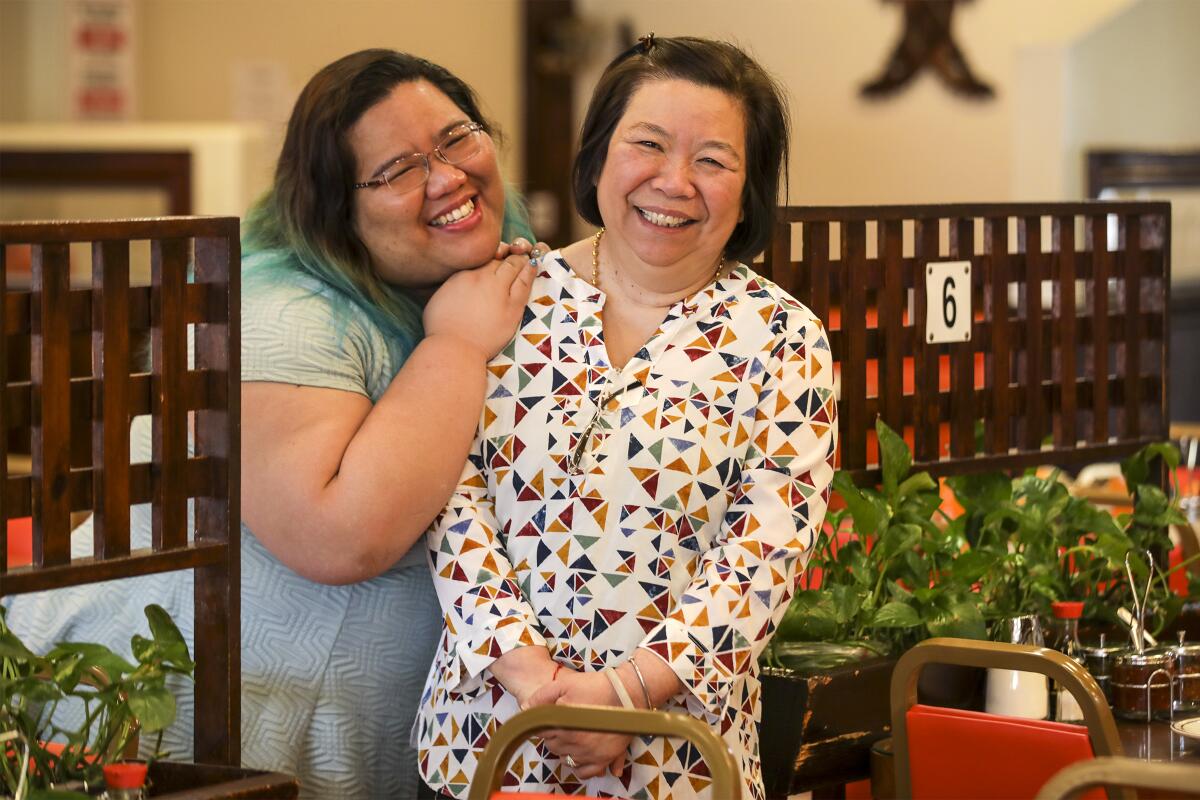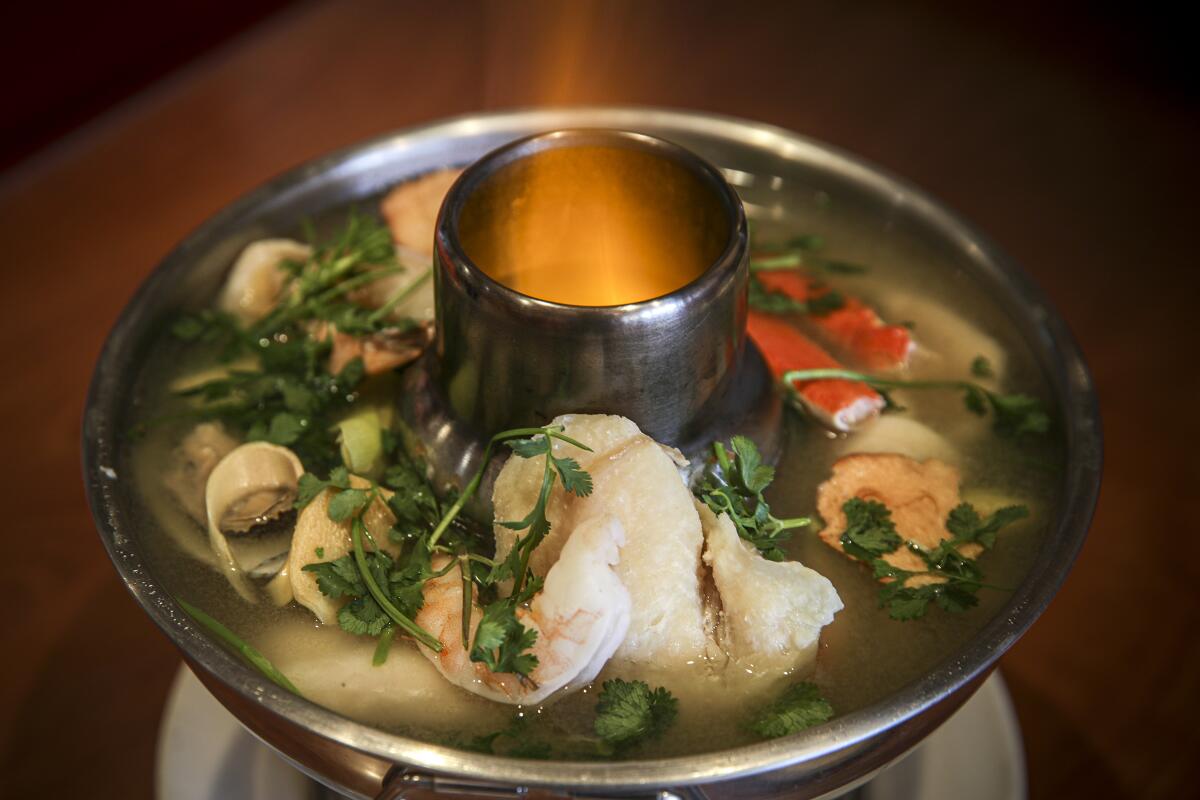How did a Thai restaurant chain become so beloved by immigrants from Mexico and Central America?

- Share via
When two Nicaraguan Uber drivers told me that a Thai place in Koreatown was their favorite restaurant in Los Angeles, I grew curious.
Then a Salvadoran driver emphatically recommended the same restaurant. Next, a driver from Guatemala told me the same thing.
This is how I found out about Ocha Classic, a Thai restaurant beloved by Central Americans, Mexicans and Latinos familiar with Koreatown. Since it opened in 1985 in Koreatown, the restaurant has expanded to seven locations on the strength of a highly loyal, and almost entirely Latino, clientele — though three locations were forced to close during the pandemic.
Although they have never advertised or done any marketing, most locations feature long lines and wait times of up to an hour. The restaurant is so successful that it has spawned dozens of copycats with various spellings of “Ocha,” a Thai word that means delicious.

Ocha also caters quinceañeras and weddings. The two busiest days of the year are Mother’s Day and Mexican Mother’s Day, El Dia de la Madre. You can tell which Central American soccer teams are doing well by counting the jerseys in the dining room. And for many of its customers, Ocha Classic is the only Thai food they’ve ever had.
Among customers and restaurant staff, theories abound as to how the connection was forged.
Dolly Porsawatdee, 30, who runs the restaurant with her family, thinks it’s probably a culinary happenstance.
Poh Tak, a spicy, sour Thai seafood soup prepared with lemongrass, chicken broth and basil, tastes somewhat similar to caldo de siete mares, a seafood soup flavored with chicken broth, lime and epazote served all over Mexico, Central and South America.
One soup uses Thai chilis, and the other chile de árbol, but no one seems to care about the difference.
At Ocha Classic, most customers order the soup with its Spanish name. It’s the most popular dish at the restaurant, thanks in no small part to the camera-ready flames flaring from the center of each hot pot dish.
Stanley Cruz, 35, dining with his family on a recent weekday, says the restaurant’s seafood soup is a popular hangover cure among Salvadorans.
“It’s like a rite of passage — that’s why I came for the first time,” Cruz said.
His wife, Sylvia, says it’s fast, efficient and affordable. People with busy schedules, especially immigrants, she said, like that the food comes out within a few minutes, and always steaming hot. The large portion sizes help, too.

Another theory posits that Central American immigrants found the restaurant because there was a popular Central American grocery, Liborio Market, located across the street.
Miguel, visiting his family from New Mexico, isn’t sure how he found out about the restaurant. But he used to eat there all the time when he was driving a truck in Los Angeles more than a decade ago and the food fills him with nostalgia. He and his family drove all the way from Downey and they had been waiting for 45 minutes.
“When he flew in, he was like, first thing, I want to go to the fire soup place,” said his niece, Lucy Cova.
Porsawatdee says the relationship between Ocha Classic and its customers really began after the Los Angeles riots in 1992.
When the looters came, homeless people stood in front of the windows to block bricks and bottles. People from the neighborhood helped stand watch and argued with protesters. It was the only building on the block that didn’t burn down, Porsawatdee said.
It seemed like their way to say thank you, Porsawatdee said. The restaurant has always fed homeless people and hungry locals with its leftovers, even after reprimands from city officials.
As the city burned, Ocha Classic stayed open at all hours of the night and day, serving as a kind of crisis cafeteria for anyone and everyone. Looters, protesters and homeless people dined shoulder to shoulder with the National Guard and police officers.
Having employees in the building helped protect it, said Pai, the owner, who asked to be known by her first name for privacy concerns. And they decided to feed everyone that would give them a chance.
“No one deserved to go without food, and my staff agreed that we had a responsibility to feed the community,” said Pai.
Since then, their customers became almost entirely Latino. The restaurant gradually took over four neighboring storefronts and now covers almost half a block. It’s not that they didn’t try to cater to Thai people, Porsawatdee said. It’s just that they were thrilled to have the customers that they did.
Some of the wait staff have worked there for more than 40 years. Porsawatdee grew up in the restaurant, and she’s watched generations of customers grow up too.
She wasn’t supposed to work here — her goal was to become a history teacher. But family is family, and eventually she was drawn into the business. She does payroll, acts as human resources and takes care of the finances and logistics.
“I’m trying to get us from old school to new school,” Porsawatdee said.
Over the years, Thai specialties like abalone with eggs and angel wings (chicken wings stuffed with a mixture of shrimp and spices) came off the menu. They added horchata, jamaica, Coronas and Modelos to the menu. Pickled jalapenos joined the soy sauce and chili garlic at each table. The mostly Thai wait staff learned enough Spanish so that people who couldn’t speak English had no problem ordering.
And because customers liked to have other kinds of Asian food with their seafood soup, they added Chinese American classics like chow mein, beef broccoli, orange chicken and egg rolls. There’s teriyaki, too, just in case.
Pai worked at an American diner and a Thai restaurant when she first came to America in the 1960s to attend college. She loved the family diner feel. The restaurant on Vermont features cozy booths and checkerboard floors in the familiar cheerful orange and rounded beige diner plateware.
But it’s obviously a Thai restaurant. Portraits of past and present kings of Thailand line the walls. There are altars with food offerings, Buddha statues and the booth in front is kept empty every morning until 11 a.m., reserved for the water spirit, a figure from Thai religious traditions. And I can personally attest that the larb at medium spicy will make your eyes water as much as any place in Thai Town.
All of these theories for Ocha Classic’s prominence in Latino Los Angeles seemed highly plausible to me, and perhaps they are all true.
But on a recent weekday, I looked around the dining room and saw birthday parties for babies and for grandmothers, teenagers on their phones and families ladling soup into bowls for others. I listened to the friendly commotion of Thai, Spanish and English mingling in the dining room. Not everything needs an explanation, I decided.
This is Los Angeles, and sometimes people from different cultures just find each other and hold on tight.
More to Read
Sign up for Essential California
The most important California stories and recommendations in your inbox every morning.
You may occasionally receive promotional content from the Los Angeles Times.















